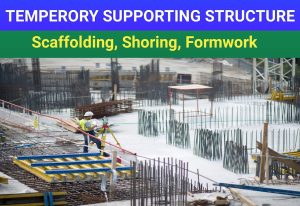Introduction
Construction projects must include temporary supporting structures because they provide the necessary stability and support to guarantee safety. Everything you need to know about temporary supporting formwork, including their kinds, applications, and advantages, will be covered in this guide.
What are Temporary Supporting Structures?
Structures used as interim supports for building projects are called transient supporting structures. They are frequently used to hold large loads, like building machinery, and to stabilize the work site.
Types of Temporary Supporting Structures
There are several types of temporary supporting structures that are commonly used in construction projects. These include:
1. Scaffolding – A temporary framework called scaffolding is used during construction to hold both workers and equipment. Usually constructed of steel or metal, it is lightweight and simple to put together.
2. Shoring – During construction, shoring, a temporary structure, is used to hold the weight of the building. Typically made of steel, it is adjustable and can be used in a variety of building settings.
3. Formwork – Formwork is a temporary structure used to hold the weight of the concrete during the construction process. It is typically made of wood, steel, or aluminum and is intended to be simple to assemble and disassemble.
Uses of Temporary Supporting Structures
Temporary supporting structures are used in a variety of construction projects, including:
1. Construction of buildings: Buildings, including towers, flats, and homes, are supported during construction using temporary supporting structures.
2. Bridge Construction: The building of bridges, such as suspension bridges, arch bridges, and cable-stayed bridges, uses temporary sustaining structures to provide support.
3. Tunnel building: During the construction of tunnels, such as those for roads, railroads, and water supplies, temporary sustaining structures are used to provide support.
Benefits of Temporary Supporting Structures
Using interim supporting buildings in construction endeavors has a number of advantages, such as:
1. Enhanced safety – Temporary supporting buildings give construction employees a secure and steady working environment, lowering the risk of mishaps and injuries.
2. Greater effectiveness – By giving the building site the support and steadiness it needs, temporary supporting structures can aid in hastening the construction process.
3. Economical – Because temporary supporting structures are simple to build and disassemble, less costly construction machinery is not required, they are frequently more economical than permanent structures.
Conclusion
Building projects must include temporary supporting structures because they offer the security and support required to ensure safety and effectiveness throughout the building process. Understanding the various kinds, applications, and advantages of impermanent supporting structures will help you finish your building project
securely, effectively, and on schedule.

Thanks for helping me understand how a scaffolding system can help construction workers in doing their jobs. I can see how this could help individuals who plan to improve their commercial buildings. I think it would be nice for companies to rent out scaffolding before doing any major upgrades to their buildings.